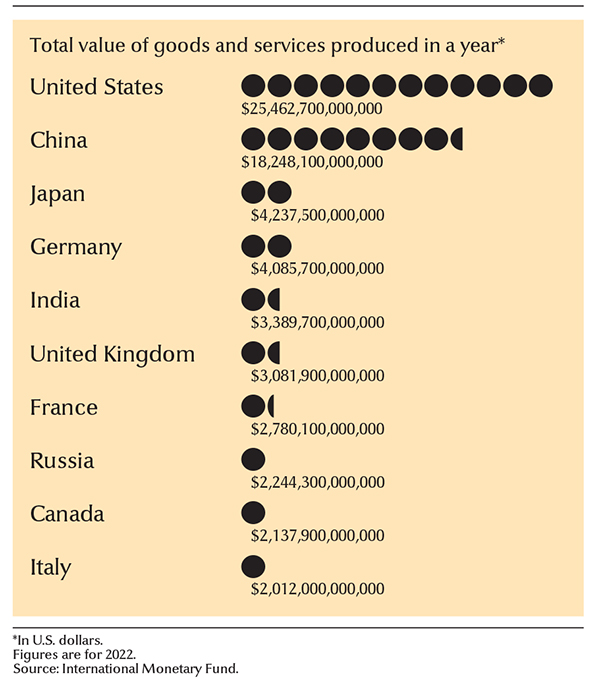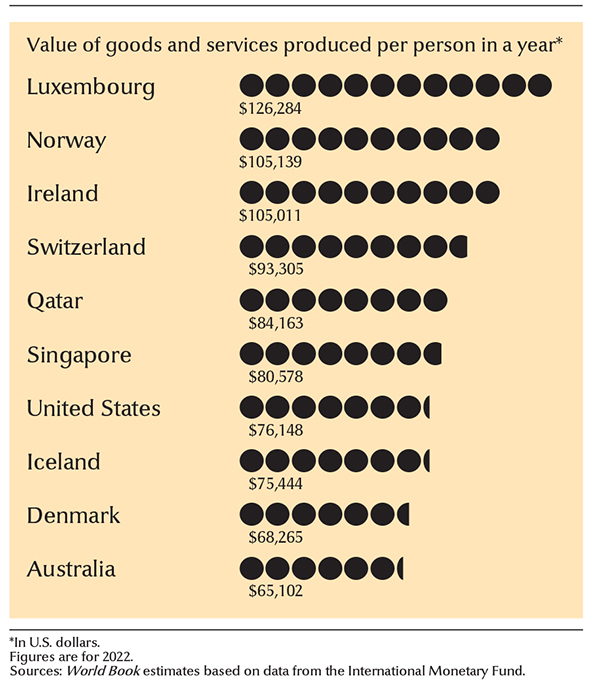Gross domestic product (GDP) is the market value of all final goods and services produced in a country during a given period. GDP is one of the most widely used measures of a nation’s total economic performance in a single year. In economics, goods are items that people value. They include food, clothes, and books. Services are activities performed that have value, such as a haircut, legal advice, or police protection. Economists use both goods and services to determine a nation’s GDP.
Measuring GDP.
One way to determine GDP is to add up the sum of spending on four kinds of goods and services in any year.
Personal consumption expenditures
include private spending on durable goods, nondurable goods, and services. Durable goods include automobiles and appliances. Nondurable goods include food and clothing. Medical care from doctors is an example of a service.
Private investment expenditures
include spending by businesses for new buildings, machinery, and tools. Businesses use these items to produce future goods and services. Private investment also includes spending on goods that are to be stored for future sale. Construction of new houses belongs to this category as well.
Government purchases of goods and services
are made up of spending by federal, state or provincial, and local governments. Such spending could be for new highways, missiles, or the wages of teachers, firefighters, and government employees. This category does not include transfer payments made by a government. This is because transfer payments are not directly spent on new goods or services. Transfer payments include unemployment benefits, welfare payments, and Social Security benefits.
Net exports
represent the value of domestically produced goods and services sold abroad less the value of goods and services purchased from abroad during the same period. In other words, economists arrive at the figure for net exports by subtracting total imports from total exports over a certain period. When economists calculate GDP by adding personal consumption, private investment, government purchases, and exports, they subtract imports because part of each of the first three expenditures includes imports. If imports are not subtracted, the sum will overestimate a country’s production for that year.
Another way to measure GDP
is to add up all of the income earned from producing goods and services. Income can be made in a number of ways. The ways include working for wages or salaries, renting property to a tenant, earning interest on such things as savings, and making a profit from owning a business. Every dollar spent on new goods and services turns into income for those that produced them. Consequently, GDP measured by income will equal GDP measured by spending after a few adjustments.
GDP can also be measured by calculating the sum of the value added by each firm to a final product during the entire production process. The value added to a product is the difference between the product’s value before a certain process and its value after the process.

Real GDP.
A nation might produce the same amount of goods and services this year as it did last year. Yet this year’s GDP for that nation could be 5 percent higher than last year’s, because GDP is measured at market value. Such a situation would occur if prices of goods and services had risen by an average of 5 percent. A rise in the price of goods in a nation over a certain time period is called inflation. To adjust for inflation when comparing production across years, economists measure GDP in constant dollars. They determine what each year’s GDP would be if dollars were worth as much during the current year as in a certain previous year, called the base year. In other words, they calculate the value of each year’s production in terms of the base year’s prices. The result is known as real GDP.
An imperfect measure.
GDP figures do not tell everything about a nation’s economy. For example, they tell little about the well-being of individuals and families. Even GDP per capita—that is, the average GDP for each person—does not tell who uses various goods and services. GDP per capita can be determined by dividing the total GDP by the nation’s population. GDP per capita cannot show, for example, how much of a country’s goods and services goes to the poorest members of the population. Nor can it show how much goes to the wealthiest. The GDP per capita does not tell anything about the quality of a country’s goods and services. It also excludes production that takes place outside of markets, such as growing food for personal use.
GDP versus GNP.
Another measure of a nation’s economy is called gross national product (GNP). GNP includes production by a country’s citizens, regardless of where the production takes place. It does not count goods or services produced by a foreign firm within a nation’s borders. GDP, on the other hand, counts only production that takes place within a country. It also includes production by foreign firms within a nation’s borders. For example, production by a Japanese-owned firm inside France would not be included in France’s GNP but would be included in Japan’s GNP. However, production by a Japanese-owned firm inside France would be included in France’s GDP, but production by a French-owned firm inside Japan would not be included in France’s GDP. In some countries, GDP and GNP can differ greatly.

See also Inflation (Measuring inflation); National budget; National debt (National debt and GDP); National income; Standard of living.
